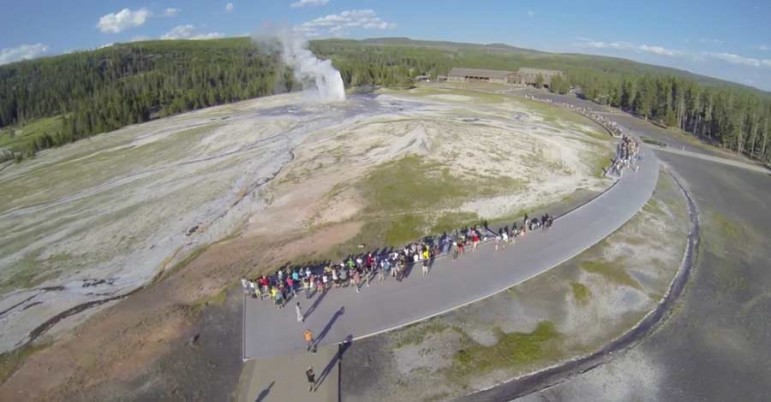
Just weeks after a visitor crashed a drone into Yellowstone National Park’s largest hot spring, park officials have filed criminal charges against the alleged pilot, and are stepping up their efforts to publicize and enforce a ban on unmanned aerial vehicles in the park.
Theodorus Van Vliet of the Netherlands has been charged in connection with an Aug. 2 incident in which authorities say he crashed his unmanned aircraft into Grand Prismatic Spring. The drone sank into the popular hot spring and has not been found.
Van Vliet is cooperating with the ongoing investigation, according to a statement released Friday by the park’s public affairs office, and faces up to $5,000 in fines and/or six months in jail if found guilty.
The National Park Service has banned drones from all national parks due to what officials describe as “concerns about public safety, wildlife disturbance and potential impacts to the visitor experience and park resources.”
The increasing ease of use and affordability of small, lightweight aerial vehicles has made them popular among photographers and sightseers who use them to capture video and photos from previously unattainable vantage points.
Various models of remote-controlled helicopters—about the size of a shoebox or smaller—can fly to heights of 100 feet or more, hovering or following a specified flight path.
Equipped with tiny, high-definition cameras, the drones can be operated with a smartphone, and can capture compelling images from a bird’s-eye view. Popular models area available online for $300 or less.
Though rangers have previously largely been working to warn and educate those using drones in Yellowstone, a recent string of incidents has prompted a crackdown, including stepped-up enforcement efforts that include potential fines and confiscation of drones.
Park staff members are still trying to determine if the drone that crashed into Grand Prismatic Springs is a threat to the iconic pool, which ranges from 200–330 feet in diameter and is more than 120 feet deep. Grand Prismatic’s picturesque bands of colors are the result of various forms of microbial organisms residing in different temperature zones within the hot spring.
Attempts to locate the device both from the ground and from a manned helicopter overflight have turned up possible areas in the pool where the unit may have come to rest. If its location can be confirmed, park staff members will determine if there is a way to safely remove the device without damaging the thermal feature.
Last week, rangers responded to another drone incident and charged Donald Criswell of Molalla, Oregon with violating the ban. Officials say Criswell flew his unmanned aircraft over the crowded Midway Geyser Basin and close to bison on August 19.
Earlier this week, charges were filed against a German national for a July 17th incident in which an unmanned aircraft crashed into Yellowstone Lake near the West Thumb Marina. Andreas Meissner faces several charges, including violating the ban on operating unmanned aircraft, giving a false report to a government employee and commercial filming without a permit.
Officials say they are working to further educate visitors about the ban, including a notice on the front page and inside the fall edition of the official park newspaper, which is distributed to visitors at Yellowstone entrance stations.
Contact Ruffin Prevost at 307-213-9818 or [email protected].
